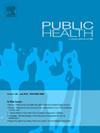The future patterns of displacement and its escalating global health needs
IF 3.9
3区 医学
Q1 PUBLIC, ENVIRONMENTAL & OCCUPATIONAL HEALTH
引用次数: 0
Abstract
Objectives
The Global Displacement Forecast Report 2025 aims to project trends in forced displacement globally, with a specific focus on the health outcomes of displaced populations. This article aims to offer primary drivers of displacement, assess the associated health impacts, and propose policy and operational responses to address the humanitarian and public health consequences.
Study Design
This is a brief report that reflects a policy analysis leveraging quantitative modeling with qualitative assessments.
Methods
The report reflects on future displacement trends through 2026. It analyzes conflict data, climate indicators, humanitarian funding trends, and health system capacities to assess displacement risks and impacts.
Results
The report forecasts an increase of 6.7 million forcibly displaced persons by the end of 2026, bringing the global total to over 130 million. Key displacement drivers include armed conflict, targeted violence (including attacks on healthcare), climate-related disasters, and shrinking humanitarian funding. Displacement is found to significantly exacerbate health crises, with rising rates of malnutrition, infectious diseases, and mental health disorders.
Conclusions
Displacement is evolving into a long-term structural phenomenon, driven by interconnected factors of conflict, climate change, and governance failure. Addressing its health dimensions requires integrated, anticipatory approaches, including the inclusion of displaced populations in national health systems, expansion of mobile and cross-border health services, and restoration of humanitarian funding.
未来流离失所的模式及其不断升级的全球卫生需求
《2025年全球流离失所预测报告》旨在预测全球被迫流离失所的趋势,特别侧重于流离失所人口的健康结果。本文旨在提供流离失所的主要驱动因素,评估相关的健康影响,并提出政策和业务应对措施,以解决人道主义和公共卫生后果。研究设计这是一份简短的报告,反映了利用定量建模和定性评估的政策分析。该报告反映了到2026年的未来流离失所趋势。报告分析了冲突数据、气候指标、人道主义筹资趋势和卫生系统能力,以评估流离失所风险和影响。报告预测,到2026年底,被迫流离失所者将增加670万,使全球总数超过1.3亿。流离失所的主要驱动因素包括武装冲突、有针对性的暴力(包括对医疗机构的袭击)、与气候有关的灾害以及人道主义资金的减少。流离失所严重加剧了健康危机,营养不良、传染病和精神疾病的发病率不断上升。在冲突、气候变化和治理失败等相互关联的因素推动下,流离失所正在演变为一种长期的结构性现象。解决其卫生方面的问题需要采取综合和前瞻性的办法,包括将流离失所者纳入国家卫生系统,扩大流动和跨界卫生服务,以及恢复人道主义资金。
本文章由计算机程序翻译,如有差异,请以英文原文为准。
求助全文
约1分钟内获得全文
求助全文
来源期刊

Public Health
医学-公共卫生、环境卫生与职业卫生
CiteScore
7.60
自引率
0.00%
发文量
280
审稿时长
37 days
期刊介绍:
Public Health is an international, multidisciplinary peer-reviewed journal. It publishes original papers, reviews and short reports on all aspects of the science, philosophy, and practice of public health.
 求助内容:
求助内容: 应助结果提醒方式:
应助结果提醒方式:


